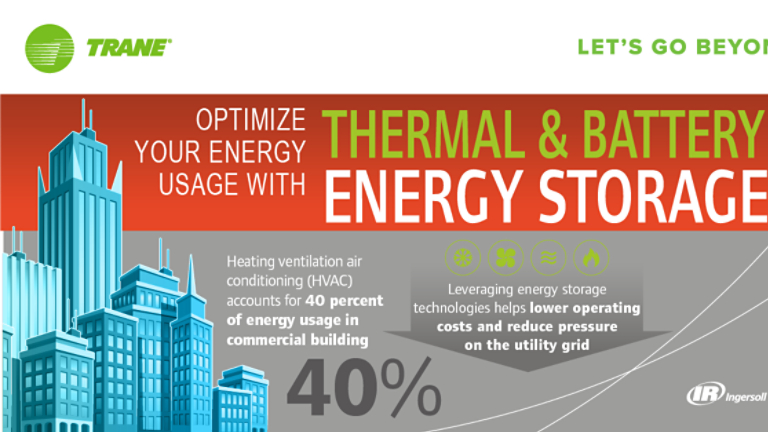Blog
Published: May 29, 2018
Thermal and Battery Energy Storage Working Together for High Performance Results
The energy market is going through a mass transformation. Fossil fuels are being used less and less and renewable energy is on the rise. As a result, an important element is disappearing – energy storage.
Thermal Energy Storage and Batteries: Working Together for High Performance Results
May 29, 2018
Optimize Building Operations with Thermal Energy Storage
The energy market is going through a mass transformation. Fossil fuels are being used less and less and renewable energy is on the rise. As a result, an important element is disappearing – energy storage. Fossil fuels are forms of stored energy whereas renewable energy is missing a storage element required for capturing energy when its plentiful. To optimize buildings for use of renewable resources, energy storage allows buildings to store ever increasing amounts of solar and wind. The ability to store abundant amounts of renewable energy not only improves sustainability but helps with energy security and resilient low-cost operation.
When planning a building’s power needs, there are a couple of energy storage options to consider — the most common being battery and thermal energy storage.
More sustainable, resilient and cost-efficient
Thermal energy storage systems utilize ice or chilled water, which is created during off-peak hours and stored in tanks, to meet a building’s peak cooling needs. Imagine holding a party. You wouldn’t wait to make ice until your guests start arriving. Instead, you’d get the ice ahead of time and store it in your freezer, using it as needed. The same idea applies to thermal energy storage for cooling the next day.
There are three main benefits of implementing a thermal energy storage system in a building: operational savings, sustainability and resiliency.
Thermal energy storage works by shifting expensive peak energy consumption to off-peak hours to avoid expensive utility demand charges. When it comes to controlling skyrocketing costs of air conditioning, thermal energy storage is a proven technology in effectively cooling buildings. In fact, it can reduce cooling bills up to 40 percent[1].
Furthermore, thermal energy loads (heating and cooling) can be stored in their intended end use format. Light can’t be stored. Moving air can’t be stored. Instead, electrons are reserved in a battery to power lights, fans, computers, etc. It would be highly inefficient and costly to store energy in a battery only to be transformed yet again to create instantaneous cooling using an electric powered chiller.

Thermal and battery energy storage together
For these reasons and more, thermal energy storage should almost always be applied for cooling needs before a battery system.
So, are batteries needed? Absolutely. Batteries address the electrical loads of the building that thermal energy storage cannot. Batteries take up less space and can power anything — including plug loads and lights.
Both batteries and thermal energy storage have their advantages. Ice storage, however, perhaps the most economical[2] , can last 40 years, with no cycle degradation and a 99% roundtrip efficiency. Plus, it is 99 percent recyclable and proven in thousands of installations. Battery storage doesn’t need a cooling load to defer and can be used year-round.
Both batteries and thermal energy storage have the potential to return energy storage elements to the grid, making electricity more reliable. Furthermore, combining ice and a battery to address a given peak demand can reduce energy storage costs by 75 percent compared to a battery alone[3].
An energy storage system is an important investment. For more technical information, check out our whitepaper.
[1] CALMAC evaluation based on utility tariff rate data and Utility Rate Database, 2017
[2] U.S. Energy Information Administration. June 29, 2012. https://www.eia.gov/todayinenergy/detail.php?id=6910#tabs_ElecStorage-2
[3] Commercial building example is based on CALMAC analysis as published in Distributed Energy Magazine, January, 2018
